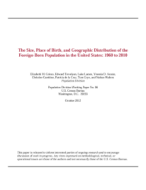The Size, Place of Birth, and Geographic Distribution of the Foreign-Born Population in the United States: 1960 to 2010
The Size, Place of Birth, and Geographic Distribution of the Foreign-Born Population in the United States: 1960 to 2010
Abstract
During the last 50 years, the foreign-born population of the United States has undergone dramatic changes, shifting from an older, predominantly European population settled in the Northeast and Midwest to a younger, predominantly Latin American and Asian population settled in the West and South. This paper uses data from the 1960 to 2000 decennial censuses and the 2010 American Community Survey to describe changes in the size, origins, and geographic distribution of the foreign-born population. First, the historic growth of the foreign-born population is reviewed. Next, changes in the distribution by place of birth are discussed, focusing on the simultaneous decline of the foreign born from Europe and increase from Latin America and Asia. The geographic distribution among the states and regions within the United States will then be reviewed. The median age and age distribution for the period will also be discussed. This paper will conclude with a brief analysis of how the foreign-born population has contributed to the growth of the total population over the last 50 years.
Others in Series
Working Paper
Working Paper
Working Paper




